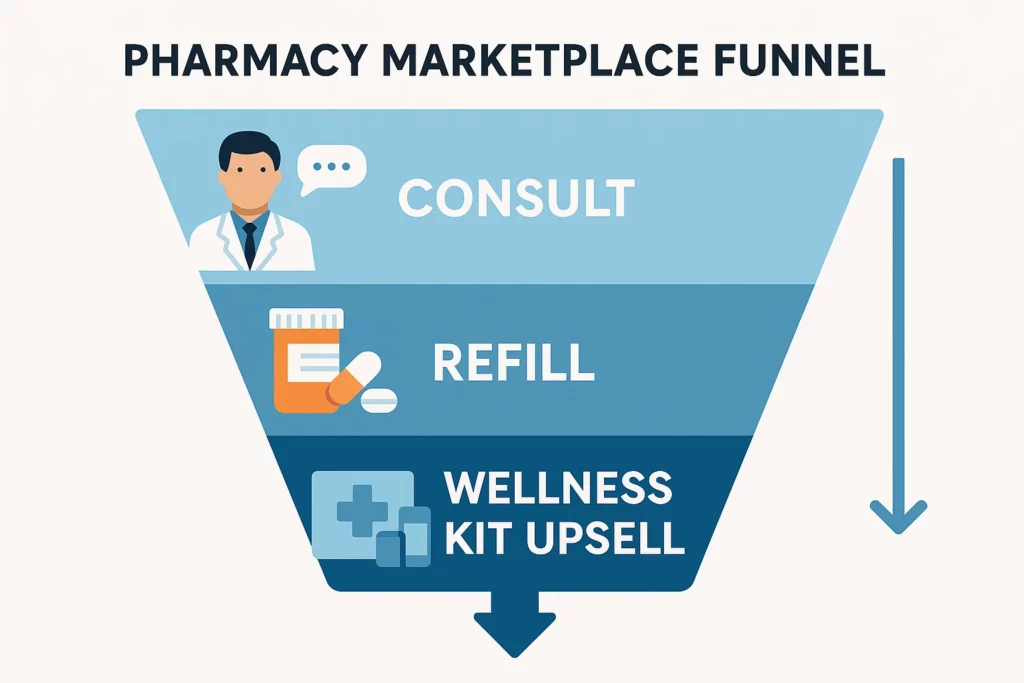Let’s rewind to a moment we’ve all had — it’s 11 PM, you’re sneezing like a cartoon character, and your local pharmacy is already lights-out. Enter the knight in shining UI: an online pharmacy app that delivers meds faster than your pizza. That “aha!” moment has sparked a surge of founders looking to turn pharmacies into platforms — and it’s not just a feel-good mission, it’s a money-making machine.
The numbers don’t lie: online pharmacy marketplaces are popping up like wellness supplements in your Instagram feed. From Apollo 24|7 to NetMeds and 1mg, these platforms blend logistics, healthcare, and tech into a smooth, scrollable experience. But what really sets the winners apart? Spoiler: it’s not just a pretty app — it’s the business model running under the hood.
Whether you’re building your own online pharmacy app or cloning a proven giant, Miracuves helps you create a platform that doesn’t just work — it works profitably. Let’s crack open the models powering this multi-billion-dollar med-tech wave.
The Online Pharmacy Market: More Than Just Pill Delivery
The digital pharmacy market is projected to cross $200 billion globally by 2030, driven by a mix of aging populations, telehealth adoption, and let’s be honest — a generation that prefers texting to talking, even with doctors.
But it’s not just about convenience. These platforms are evolving into full-blown health ecosystems: prescription refills, lab test bookings, doctor consultations, even wellness subscriptions.

Top Business Models That Drive Pharmacy Marketplace Success
1. Inventory-Led Model
In this model, the platform stocks and ships medicines directly. Think of it like running your own Amazon warehouse — but for pills.
Pros:
- Better margins
- Full control over quality and logistics
Cons:
- High initial capital for warehousing
- Complex cold-chain handling for certain meds
Example: 1mg uses this hybrid model with its own inventory + partners
Read Also :-How to Market a Pharmacy Marketplace Successfully After Launch
2. Marketplace Aggregator Model
This is the Airbnb of meds. You don’t stock anything — instead, you list pharmacies and connect users to them. The platform earns a commission on every order placed.
Pros:
- Scalable, asset-light
- Faster go-to-market
Cons:
- Lower margin control
- Dependency on third-party pharmacies
Example: NetMeds leverages this approach in tier 2/3 cities
Inventory vs Marketplace Model: Business Comparison Table
| Feature / Factor | Inventory-Led Model | Marketplace Aggregator Model |
|---|---|---|
| Initial Investment | High – requires warehousing, logistics, inventory | Low – minimal infra, partners handle stock |
| Control Over Supply | Full – from storage to shipping | Limited – depends on partner pharmacies |
| Time to Launch | Longer – infrastructure setup needed | Faster – plug in verified pharmacy partners |
| Profit Margins | Higher – direct product markup | Lower – revenue via commissions |
| Customer Trust | Strong – better control on product quality & delivery | Depends – varies based on pharmacy partner reputation |
| Scalability | Moderate – tied to operational expansion | High – add partners city by city |
| Compliance Complexity | High – full regulatory and licensing responsibilities | Shared – partners handle drug license adherence |
3. Subscription-Based Wellness Model
Why sell a pill when you can sell peace of mind? Platforms are bundling services like medicine reminders, priority delivery, doctor calls, and wellness kits into monthly or annual plans.
Popular features:
- Unlimited free delivery
- Health score monitoring
- Discounts on diagnostics
Recurring revenue = startup holy grail
Example: Practo Plus offers subscription tiers for individuals & families
Learn More :-Smart Business Models Behind Successful Pharmacy Marketplaces
4. Affiliate & Sponsored Listings
Pharmacy marketplaces often highlight “featured” brands or products — yes, that multivitamin showing up first? That’s paid placement.
Revenue flows in from:
- Pharma brands sponsoring products
- Affiliate commissions from health services (insurance, consultations)
Example: Flipkart Health+ features promoted ayurvedic products
5. Private Label Sales
Want higher margins? Sell your own brand of supplements, skincare, or wellness kits.
Think: Amazon Basics but for multivitamins.
These white-labeled SKUs can yield 2–3x profit margins compared to retail pharma. Add smart branding and influencer marketing? You’ve got a mini empire.
Example: PharmEasy Essentials, a line of branded OTC products
6. Integrated Telehealth Ecosystem
This one’s for the long-haul. You don’t just sell meds, you sell a full healthcare loop: chat with a doc → get a prescription → order meds → schedule a follow-up.
Revenue streams:
- Consultations
- Diagnostics booking fees
- Cross-selling wellness services
Example: Apollo 24|7 does this seamlessly within one app
Hybrid Models are the Real MVP
The smartest pharmacy platforms don’t just stick to one model — they stack them.
Scenario: A user signs up for a subscription, books a doctor consult, gets a prescription, buys private label meds, and the platform earns through all those touchpoints.
Think of your platform as a funnel, not a one-time transaction.

Build a Profitable Pharmacy Marketplace with Miracuves
You’ve got the ideas, we’ve got the blueprints. At Miracuves, we specialize in pharmacy app clones and custom platforms that are feature-rich, scalable, and ready to monetize from day one. Whether you want to mimic 1mg or mix models to create your own hybrid marketplace — we’ll help you build fast and build smart.
Read More :-Smart Revenue Models for Your Pharmacy Marketplace
Conclusion
Pharmacy marketplaces are no longer just pill pushers — they’re powerful platforms with multiple revenue taps. From subscriptions to private labels to digital consults, the smart money is in stacking models, not just selling pills.
At Miracuves, we help innovators launch high-performance app clones that are fast, scalable, and monetization-ready. Ready to turn your idea into reality? Let’s build together.
FAQs
Can I launch a pharmacy marketplace without owning a warehouse?
Absolutely. Use the marketplace aggregator model to partner with local pharmacies and fulfill orders through them.
What’s the most profitable business model?
Private label sales combined with subscriptions and telehealth features can yield the highest ROI over time.
Is this legal in all countries?
Nope. Always check local drug distribution laws and digital health regulations. A legal consult is your best friend here.
How much does it cost to build a pharmacy app?
Costs can range from $10K to $100K+ depending on features, integrations, and compliance. MVPs can start lean with core features.
Do I need a medical license to start?
You don’t need to be a pharmacist, but your platform will likely need to partner with licensed entities and comply with local healthcare laws.
How do I handle prescriptions digitally?
Offer teleconsultations with certified doctors or let users upload prescriptions. Use OCR tech to verify before allowing purchases.








